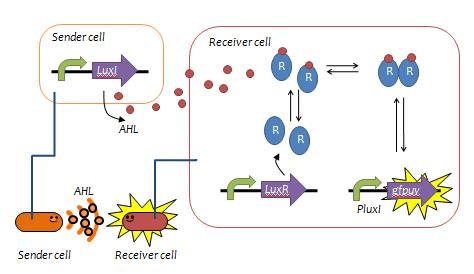Team:Chiba/Project
From 2009.igem.org
E.coli Time Manager -Since 2008- 
| Home | The Team | Parts | Reference | Notebook | Protocols | Links | Acknowledgements | Contact |
|---|
|
The Project |
Introduction
(手術予定)
そして、昨年は2段階の通信しか創れなかった。バリエーションが乏しい。
It has been demanded in biological engineering that making the function that organisms sense the passage of time. We can utilize the excellent functions of organisms such as material synthesis or sensing as a device for drug delivery system or physical exam when these functions have been time-controlled as we like. However we can control cells individually, without method to control them all together, advantage of excellent functions may attenuate. Then we want to make the timer that cells works concurrently. Project DesignFor making some timers without need of synchronizer system and that can be used in a single system we try to make following design.
2) Project Design ⑤Receiver側のAHL通信の仕組みを図説する。(1,AHLが入るところ(培地調節) 2,Receiver中のLuxR 3,Receiver中のReporter)
Signaling System
なんじゃこりゃーなおします。--Yoshimi 13:22, 20 October 2009 (UTC) In this project, we use acylated homoserine lactones (AHLs), signaling molecules used for [http://en.wikipedia.org/wiki/Quorum_sensing quorum sensing] in gram negative bacteria. Senders express LuxI or similar enzymes, which catalyze the production of AHLs, under the control of a constitutive (Tet) promoter. Each cell thus generates AHL more or less at a constant rate. AHL can freely permeate cell membranes and are detected by neighboring cells. Receivers constitutively express LuxR proteins (or a similar ortholog), the protein that detects AHL concentrations. When AHLs bind LuxR proteins, the AHL-LuxR complex activates the Lux promoter. The threshold [AHL] at which switching occurs is determined by the affinity of AHL for the particulr LuxR ortholog. about quorum sensing) Experiments, Results & DiscussionLuxR mutantづくり
Experiments
(手術予定) ⑥Mutantを創る。(Error-proneが良い理由:バリエーションを創りやすい。新たなBiobrick作成方法としてError-prone PCRとスクリーニングをセットにしMutant-Partsの作り方を説明する。) ⑦さらに詳しい実験方法(Biobrickからerror-prone PCRをおこなったことなど) ⑧得られたデーター(なぜ8000のライブラリを、200に絞り、どうやって13sampleを選び出したのか説明) 得られたLuxR mutantのcharacterization⑨LuxR Mutant 個性確定実験の実験方法 ⑩100 nM培地での応答の遅れについての結果 ⑪AHL濃度を振った場合の、6h後の蛍光強度の差についての結果 ⑫LuxR Mutantの個性と、変位が入っている部分からの考察 より良い絵を描くために/To draw more better picture
培地のよりよい条件を見つける 私たちはデモをよりはっきり見せるために必要な培地の条件を調べた。
1)agar 1% and 薄い(約1.5 mm) 2)agar 5% and 厚い(約7 mm) 3)agar 1% and 薄い(約1.5 mm) 4)agar 5% and 厚い(約7 mm)
培養後、Nitro Cellulose filterごとそれぞれの培地をカッターで切り出して同じ厚さの2000 nMのAHLを含む培地にのせて目視で蛍光の観察を始めた。
この実験をした結果、各mutant LuxRが光りだす時刻の差は、(4)のagar 5% and 厚い 培地で最も大きい差が見られた。 つまり厚さが薄かったりagar が少なかったりした培地上でのmutant LuxRが光りだす時刻のばらつき具合よりも、この(4)の培地上でのばらつき具合の方がはっきりしていた。
私たちは、ReporterとしてGFPuv, sfGFP, mRFP, mCherry, mOrangeを使って上に挙げたものと同じ実験をした。
Demonstration⑯E. coli Timer完成デモ (⑰できればアニメ) Conclusions手術予定 18・Biobrickを使って(iGEM的には)新たな方法(error-prone PCR)を用い、新パーツをつくりました。 ・何通り(ただいま確認中)のバリエーションの遅れを生み出せました。(Mutant+WT:4~5種、gel調節:2種、Reporters: 4通り・・・これらの組み合わせの分(タイミングがかぶるのは除く)だけ時間差をうみだせた!) ・demonstrationをおこないました。
|
 "
"


